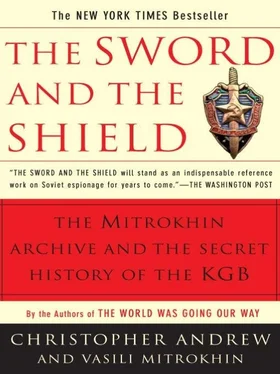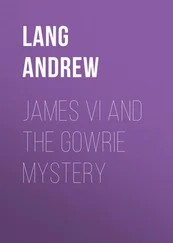The KGB knew nothing of the CIA’s ill-founded suspicions. Ironically, while Nosenko was languishing in solitary confinement in a prison cell, the Centre was working on a plan for both him and Golitsyn to be assassinated by the illegal PAUL, if they visited the 1967 Montreal World Fair (which, for rather different reasons, neither did). 66
The Centre’s continuing inability to track down its traitors was well illustrated by the case of the illegal Yevgeni Runge (codenamed MAKS), who defected with his wife Valentina Rush (ZINA) to the CIA in Germany in October 1967. Following the KGB’s traditional practice of using insulting codenames for defectors, MAKS was renamed GNIDA (“Nit”). Like his predecessors, he was secretly condemned to death in absentia. Enormous efforts involving several other Soviet Bloc services were devoted to operation TREZOR, the long and unsuccessful attempt to track down and liquidate Runge. More than fifty of the Runges’ friends and relatives in the Soviet Union, East and West Germany were placed under surveillance; every item of their correspondence which passed through the Soviet Bloc was opened and examined; their homes were bugged and secretly searched. The Stasi mounted a support operation, codenamed COBRA, which set out to cultivate Valentina Rush’s sister, Renata Ludwig, and one of her relatives, Ernst Buchholz, who lived in West Berlin. After fifteen years of failure, operation COBRA was finally abandoned.
The KGB also sought the assistance of other Soviet Bloc intelligence services in finding an assassin capable of liquidating Runge in north America, where it was assumed he had taken refuge. The Centre’s preferred candidate was a Hungarianborn West German criminal, codenamed JAGUAR, who had been recruited by the AVH for “special actions” against anti-Communist Hungarian émigrés. On July 1, 1968 JAGUAR blew up the Danube printing house in Munich, which produced émigré publications. He also set fire to the editorial offices of two Hungarian émigré newspapers, putting one of them out of business. For these operations JAGUAR received 40,000 Hungarian forints and 1,000 West German marks from the AVH. Impressed by his “special actions” in Munich, the KGB decided to employ him for operation TREZOR. JAGUAR was shown photographs of Runge and his wife and agreed to hunt them down. Once he had left for the United States, however, he disappeared without trace—together, presumably, with the operational funds allocated to him by the KGB. Following JAGUAR’s disappearance, the Centre asked the East German Stasi and the Bulgarian DS whether they had contacts among American gangsters or mafiosi who would take out a contract on Runge. Neither was able to suggest a suitable assassin. 67
AS WELL AS attempting to liquidate major traitors, the Thirteenth Department and Department V were also responsible for administering lesser punishments to other defectors whose crimes were not considered to merit the death penalty. The November 1962 plan for dealing with defectors also specified “special action” against the world-famous ballet dancer Rudolf Nureyev, who had defected at Le Bourget airport in Paris during a tour by the Kirov Ballet in 1961. 68The KGB had begun a campaign of intimidation immediately after Nureyev’s defection. On the night of his first major performance with a Western company, when he was due to dance the part of the Blue Bird in a Paris production of Sleeping Beauty, he received emotional letters from both his parents and his former ballet teacher, appealing to him not to betray the fatherland. Having steeled himself to go ahead, Nureyev then found his performance interrupted:
I had barely come on to the stage… when shouting and whistling broke out, almost drowning Tchaikovsky’s music. I went on dancing the Blue Bird, but beyond the haze of the footlights… I was perfectly aware that some communists were trying to sabotage the performance. I could hardly hear the music and I saw pieces of what looked like glass thrown on to the stage at me but I kept on dancing. 69
The KGB’s early attempts at intimidation failed. On February 21, 1962, amid a blaze of publicity, Nureyev made his Covent Garden debut, dancing with Margot Fonteyn in Giselle. To those who saw that unforgettable performance and the twenty-three curtain calls which followed, it was already clear that one of the greatest partnerships in the history of dance had been born. 70The Centre was outraged not merely by the public adulation of a notorious defector but also by Nureyev’s publication a few months later of memoirs describing his “leap to freedom” in the West. Though the November 1962 plan of campaign against leading defectors did not specify the nature of the “special action” to be employed against him, it was clear from the context that it would henceforth involve a good deal more than sprinkling broken glass on the stage. 71Subsequent FCD directives discussed schemes (which were never successfully implemented) to break one or both of Nureyev’s legs. 72
In the summer of 1970 one of Nureyev’s best-known near-contemporaries, Natalia Makarova, defected from the Kirov Ballet during a London season at the Royal Festival Hall. The KGB report on the defection predictably condemned her as a “politically immature individual, with low moral qualities.” 73In reality, the main motive for her defection, like Nureyev’s, had been the quest for greater artistic freedom. 74A joint memorandum by the heads of the First and Second Chief Directorates proposed that, if a way could be found to injure Nureyev without the hand of the KGB being obvious, a similar “special action” should be undertaken against Makarova. As usual, the reference in their memorandum to physical injury was expressed in euphemistic bureaucratic prose:
Depending on the results of special actions taken with respect to Nureyev, aimed at lessening his professional skills, [the KGB] should consider carrying out a similar action with respect to Makarova, in order to localize the negative effect of her forthcoming performances in Britain and the United States. If the British propaganda organs are activated and information provided by her is used to slander Soviet life, additional measures will be devised. 75
An approach was made by the Centre to the Bulgarian intelligence service to seek the possible assistance of one of their agents in a company where Makarova was due to dance. On one occasion Makarova was slightly hurt in an accident behind the stage caused by a beam falling from the set. The files seen by Mitrokhin, however, do not make clear whether this was the first nearly successful “special action” by the KGB against a defecting ballerina or merely an act of clumsiness by a stagehand. 76
Since the defection of the reluctant assassin, Bogdan Stashinshky, in 1960, KGB operations against traitors living in the West had been totally unsuccessful. Though enormous amounts of time and resources had been devoted to tracking down defectors and preparing to kill and maim them, the only successful liquidation claimed by the Centre, the assassination of Hayhanen, was entirely fraudulent. It is just possible that the KGB was responsible for the minor injury to Natalia Makarova. But the probability is that its pursuit of traitors during the decade up to 1970 ended in complete failure.
APPENDIX 1
INSTRUCTIONS FOR DISARMING THE MOLNIYA (“LIGHTNING”) EXPLOSIVE DEVICE
Instructions for Disarming the MOLNIYA Explosive DeviceFCD Directorate S guidance to residencies on the correct procedure for removing radio transmitters from booby-trapped caches
1. When digging out the container from the earth, take care not to strike the handle by chance. Dig until the upper surface of the container with the handle comes to light; remove the board and the plywood which cover the container.
Читать дальше











